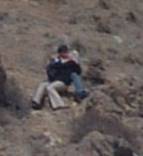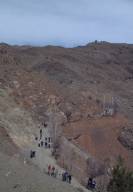After a simple breakfast I am experiencing Tehran traffic in daylight. Traffic is an overwhelming consideration, as I will later find out, in this country. There are simply too many cars, and not enough infrastructure to carry those cars. It is constant chaos.

 In my first venture into it we head north to a mountain overlooking Tehran known as Tochal. Being Friday, it is a day off for most people in this country. Thousand of mostly young Iranians have come here to walk up the road or hike up the cliffs. A uniformed man stops four very attractive young women. I am told that in the eyes of the police they are not appropriately dressed for public as they are wearing tight clothes. Their only deference to Islam is the loosely worn headscarves.
In my first venture into it we head north to a mountain overlooking Tehran known as Tochal. Being Friday, it is a day off for most people in this country. Thousand of mostly young Iranians have come here to walk up the road or hike up the cliffs. A uniformed man stops four very attractive young women. I am told that in the eyes of the police they are not appropriately dressed for public as they are wearing tight clothes. Their only deference to Islam is the loosely worn headscarves.
Men and women also are not permitted to touch each other in public according to Islamic law. However, that doesn’t mean it never happens, as our observation up the mountain discovers. We notice what appears to be someone far up the slope. Using the zoom of my camera shows there are actually two people who are perhaps closer than the Republic would ordinarily permit. There is some behaviour that is simply too natural for any law to curtail.
The landscape is rugged with mountains looming to the north. They are barren, devoid of any vegetation. A strong wind swirls dust and debris around us. Tehran is a city whose population is well over ten million, having doubled in less than twenty years. Building sites are continually being developed up the mountain slopes. This population also is young, with over half under the age of thirty.
My time in Tehran is cut short, as I have a four thirty flight to Shiraz. This requires another round of Tehran traffic. The city is choking with cars, fulfillment of a government decision to build millions of cheap vehicles for the masses. The brand name is the Paykan. The demand for transportation far exceeds the supply. At virtually every street corner I see lines of people trying to flag down a ride, for a price. Many vehicles with empty seats are usually seen pulling over to the curb (or within a few meters) and negotiating the price of a ride with those standing by the road. The starting price for a straight line ride of a couple of kilometers is 100 toman (about fifteen CDN cents). If you want the car to yourself, you have to pay for all five seats, or five times the price. If you are in the front bucket seat, expect to share it.
Our initial flight takes us to Shiraz, where, after a three-hour stopover, we fly to Esfahan, arriving at 9:30 that evening. Hundreds of years ago this city was the capital. At its height, the Shah Abas ruled an area extending from Turkey to India from this city.
The Esfahan airport has recently been rebuilt and has a modern feel to it. The buildings have a fine stone façade. Esfahan is a city of art. This becomes clear to me as our taxi takes us to our hotel. Our driver welcomes me to “antique” Iran. He shares a laugh with Masoud on this comment as I realize he is not just talking about the buildings. We drive down a wide boulevard on the south side of the Zayandeh River. This takes us past some of their famous bridges, first the Khajou Bridge, the Jouee Bridge, and finally stopping in front of Se-o-Se Pol Bridge. Our hotel, the Suites, and our second floor room, overlooks this famous site.

No comments:
Post a Comment